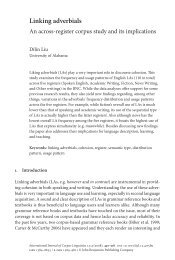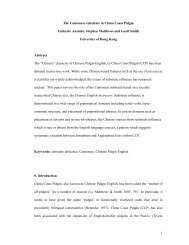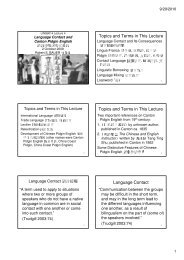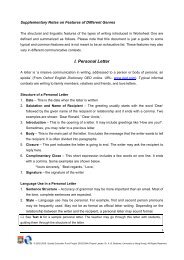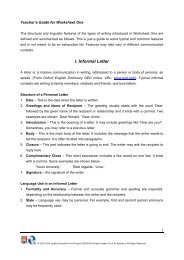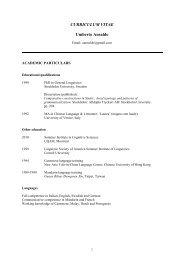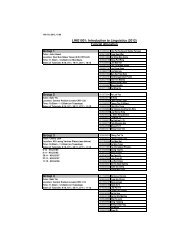The Bilingual Brain: Bilingual Aphasia
The Bilingual Brain: Bilingual Aphasia
The Bilingual Brain: Bilingual Aphasia
Create successful ePaper yourself
Turn your PDF publications into a flip-book with our unique Google optimized e-Paper software.
202 FRANCO FABBRO<br />
of knowledge this person has of these three languages, he or she should definitely<br />
be considered a bilingual.<br />
Given these methodological premises, at present more than half of the world population<br />
is multilingual (Grosjean 1982, 1994). As a direct consequence, multilingual<br />
individuals suffering from developmental or acquired speech or language disorders<br />
do not represent isolated and exceptional cases—as one might be inclined to think<br />
when reading the specialized literature—but rather the majority of clinical cases<br />
(Paradis, 1998a).<br />
<strong>The</strong> Assessment of <strong>Bilingual</strong> <strong>Aphasia</strong><br />
A systematic assessment of all the languages known by an aphasic patient is an<br />
essential prerequisite for both clinical procedures (diagnosis, rehabilitation program,<br />
assessment of progress in recovery, etc.) and neurolinguistic research on multilingualism.<br />
For this reason, Michel Paradis and associates (Paradis & Libben, 1987;<br />
Paradis, 2001a) developed the <strong>Bilingual</strong> <strong>Aphasia</strong> Test (BAT), which consists of three<br />
main parts: part A for the evaluation of the patient’s multilingual history (50 items),<br />
part B for the systematic and comparable assessment of language disorders in each<br />
language known by the subject (472 items in each known language), and part C for<br />
the assessment of translation abilities and interference detection in each language<br />
pair (58 items each). <strong>The</strong> BAT is currently available in 65 languages (part B) and<br />
160 language pairs (part C). Parts B and C of this test have not been simply translated<br />
into different languages, but rather adapted across languages. For example, when<br />
adapting the BAT verbal auditory discrimination test into Friulian, English items<br />
were not simply translated. In fact, for each item the authors had to find four Friulian<br />
words that differed from each other by only one initial phoneme and could also be<br />
easily represented by a picture. Thus, the English stimuli ‘‘mat, cat, bat, hat’’ became<br />
‘‘cjoc, çoc, poc, toc’’ (drunk, log, chicory, piece).<br />
<strong>The</strong> persons administering the test are not required to make any judgment: they<br />
simply write down the answers given by the patient, which will then be processed<br />
by means of a computerized program indicating for each part (B and C) the absolute<br />
number and the percentage of correct answers for each linguistic skill (comprehension,<br />
repetition, judgment, lexical access, propositionizing, reading, and writing) and<br />
for each linguistic level (phonology, morphology, syntax, lexicon, and semantics).<br />
For some parts of the test, such as spontaneous speech, description of a short story<br />
illustrated by pictures, and spontaneous writing, a thorough neurolinguistic analysis<br />
on the basis of strict, objective criteria is required. Assessment of bilingual aphasics<br />
by the BAT provides a quantification and classification of language disorders for<br />
each language, thus allowing a direct comparison of performances in the different<br />
languages known by the patient. Before the BAT, bilingual aphasia was studied using<br />
different test instruments; for this reason it was very hard to compare different studies<br />
(cf. Paradis, 1983, 1993). <strong>The</strong>refore, previous findings should be seen as a useful<br />
starting point for a more thorough and systematic neurolinguistic analysis (Fabbro,<br />
1997).<br />
As pointed out by Grosjean (1989, 1998) and stipulated in the implementation<br />
manual (Paradis & Libben, 1987), when assessing residual language abilities in bilingual<br />
aphasics, a series of methodological precautionary steps should be taken: each<br />
language should be assessed on a separate day and the code-switching habits of the<br />
patient before pathological onset should be thoroughly described, e.g., asking relatives<br />
and friends for relevant information. Indeed, in some bilingual communities<br />
code switching is sociolinguistically accepted and quite common during everyday<br />
conversation (e.g., among English–French bilinguals in Montreal, Canada), whereas



